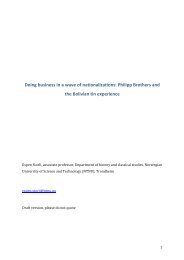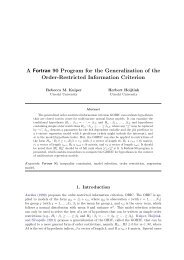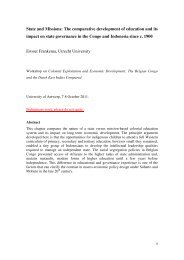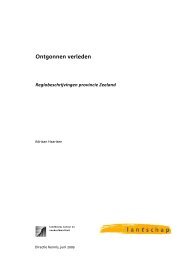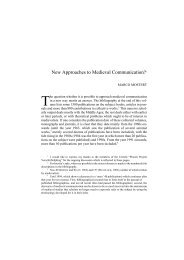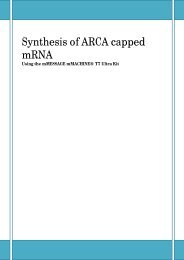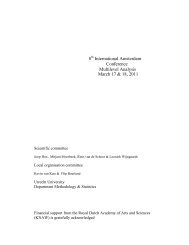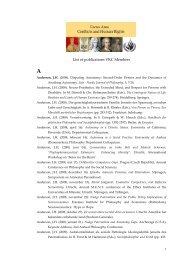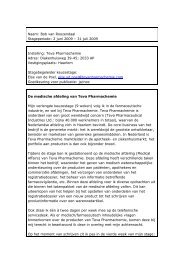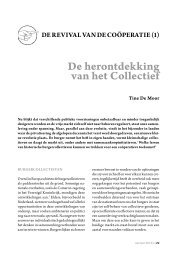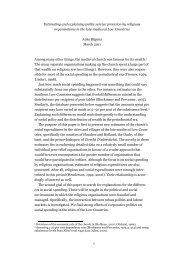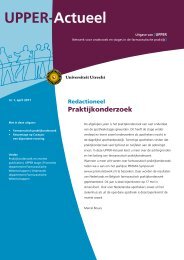Family Structure and Business Organization: Sephardic ... - Partner
Family Structure and Business Organization: Sephardic ... - Partner
Family Structure and Business Organization: Sephardic ... - Partner
Create successful ePaper yourself
Turn your PDF publications into a flip-book with our unique Google optimized e-Paper software.
Draft – Not for circulation without permission<br />
had an initial duration of three or four years, although it could be renewed. 58 Accom<strong>and</strong>ite<br />
became tools through which merchants raised capital among aristocrats as well as investors from<br />
a broader social spectrum who shunned the direct involvement in commercial ventures or wanted<br />
to diversify. 59 Several wealthy Florentines, noblemen <strong>and</strong> otherwise, subsidized the partnership<br />
of Paolo Girolamo Medici <strong>and</strong> Enea Beroardi in Lisbon through accom<strong>and</strong>ite, for example. 60<br />
Tuscan Jews rarely underwrote accom<strong>and</strong>ite in the seventeenth <strong>and</strong> eighteenth centuries.<br />
61 Those who did were for the most part Italian Jews running shops or small trades in Florence,<br />
Pisa <strong>and</strong> other towns such as Arezzo <strong>and</strong> Monte San Savino. Jewish merchants based in Livorno<br />
<strong>and</strong> involved in long-distance trade are significantly underrepresented among the surviving series<br />
of accom<strong>and</strong>ite. The few who signed such contracts were normally not related by kinship. That<br />
was the case of Enriques <strong>and</strong> Franchetti, who underwrote an accom<strong>and</strong>ita in 1782 to run a<br />
partnership with a main house in Tunis <strong>and</strong> branches in Livorno <strong>and</strong> Smyrna. It is also<br />
noteworthy that the frequency with which Jews sealed these contracts intensified in the second<br />
half of the eighteenth century, <strong>and</strong> in the 1770s in particular, when the composition of the Jewish<br />
mercantile community of Livorno became more diverse <strong>and</strong> the <strong>Sephardic</strong> hegemony broke<br />
down. Furthermore, unlike the accom<strong>and</strong>ite of Christian merchants such as Medici <strong>and</strong> Beroardi,<br />
those involving Jewish merchants in Livorno began to enlist several sleeping partners only in the<br />
1760s. Finally, accom<strong>and</strong>ite between Jews <strong>and</strong> Christians first appeared in the 1770s but<br />
remained a rarity. This fact is relevant considering that no legal prohibition existed against these<br />
contracts, which we could otherwise assume might have been instrumental in breaking closed<br />
ethnic, religious, <strong>and</strong> familiar communities of traders. 62<br />
58 The commenda was a nearly ubiquitous contract for mercantile associations in the medieval<br />
Mediterranean. It came in many versions, but the fundamental difference was between unilateral <strong>and</strong> bilateral<br />
contracts. In unilateral commende, a sedentary partner provided all the liquid capital necessary for the venture <strong>and</strong>,<br />
while a managing partner undertook the trip overseas <strong>and</strong> acted as commission agent for the two partners in<br />
exchange for a share of the profit (usually set at 25%). Bilateral commende normally stipulated that the traveling<br />
partner contributed a third of the capital <strong>and</strong> received half of the profit. All commende were limited in time to the<br />
duration of the voyage. Moreover, the investor alone bore all losses of capital for the traveling agent was not liable<br />
toward third parties for debts incurred by his principal. On commenda contracts, see WEBER 2003; LOPEZ–<br />
RAYMOND 1955: 174-9; UDOVITCH 1970; PRYOR 1977.<br />
59 On Tuscan accom<strong>and</strong>ite during the early modern period, see CARMONA 1964; LITCHFIELD 1969b;<br />
GOODMAN 1981: 424-29; BERTINI 1994. The legal clauses concerning Tuscan accom<strong>and</strong>ite are recapitulated in<br />
FIERLI 1803. For a list of the most prominent Christian merchant houses operating in Livorno in 1674, many of<br />
which raised capital with accom<strong>and</strong>ite contracts, see ASF, Archivio Magalotti, filza 225 (see also Chapter 8,<br />
footnote 159). On French contracts en comm<strong>and</strong>ite in the seventeenth <strong>and</strong> eighteenth centuries, see LÉVY-BRUHL<br />
1938: 33-40.<br />
60 ASF, Mercanzia, 10854, fols 39r-40r, 88r-89v; 10855, fols 36v-37r; 10856, pp. 21-22, fols 60r-61r, 91v-<br />
92r. Medici <strong>and</strong> Beroardi rescinded their accom<strong>and</strong>ita in November 1736. They each continued to use this type of<br />
contract to raise capital for their new partnerships with Giuseppe Sartori <strong>and</strong> Luigi Niccolini, respectively; ASF,<br />
Mercanzia, 10856, fols 114r-115v <strong>and</strong> 126v-127v. At Medici’s death in 1743, Niccolini started a new business with<br />
Giuliano Galli in Lisbon <strong>and</strong> again raised money in Florence through a series of accom<strong>and</strong>ite; ASF, Mercanzia,<br />
10858, fols 38r-v, 125v-126r.<br />
61 This <strong>and</strong> the flowing observations are based on the examination of the copies of Tuscan accom<strong>and</strong>ite<br />
registered in the merchant court of Florence from 1632 to 1777 (ASF, Mercanzia, 10841-10859).<br />
62 For Enriques <strong>and</strong> Franchetti, see FILIPPINI 1989: 143-4 <strong>and</strong> 1999; FUKASAWA 2000: 72n19. Other<br />
examples of accom<strong>and</strong>ite between Jewish merchants in Livorno include those between Moses Franco Albuquerque<br />
<strong>and</strong> Moes Alatone in 1670 (ASF, Mercanzia, 10847, fols 56v-57r), Lopes Pereira <strong>and</strong> Raphael Ergas in 1734 (ASF,<br />
14



